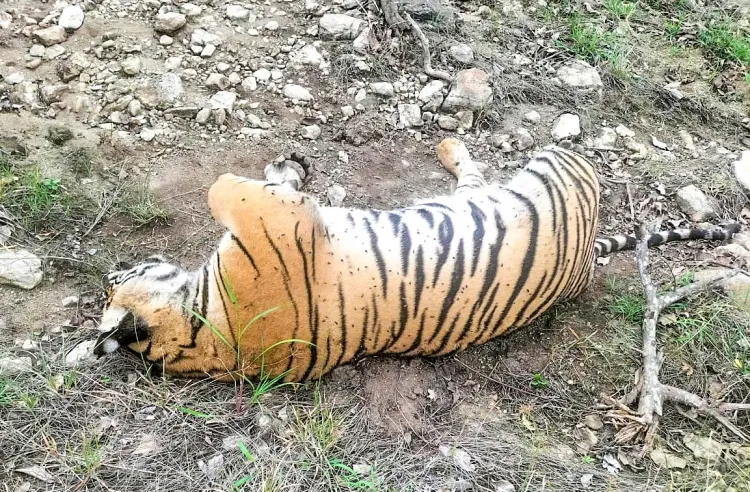Is the Use of Odourless Pesticide Carbofuran Confirmed in the Death of K’taka Tigers?

Synopsis
Key Takeaways
- Carbofuran is an odourless pesticide linked to tiger deaths.
- A specific investigation is underway regarding the use of Carbofuran.
- Authorities have suspended officials amid the scandal.
- Three suspects have been arrested for their involvement.
- The case highlights urgent wildlife protection needs.
Chamarajanagar, July 12 (NationPress) The Chief Conservator of Forests (CCF) T. Hiralal has revealed that laboratory findings confirm the presence of the pesticide Carbofuran in the tragic deaths of five tigers in the Male Mahadeshwara Wildlife Sanctuary located in Chamarajanagar district, Karnataka.
In a statement to the press on Saturday, Hiralal, who is also part of the high-level investigative panel, mentioned that both the Forensic Science Laboratory (FSL) and the Institute of Animal Health and Veterinary Biologicals (IAH&VB) have validated the use of Carbofuran in this case of tiger fatalities.
He explained that Carbofuran was applied to the carcass of a cow, which had been hunted by a tigress and her four cubs. The motive for this act stemmed from vengeance due to the cow’s death. The tigers perished after ingesting the tainted meat, he noted.
Carbofuran, which is an odourless pesticide, was specifically administered to the fatty hind section of the cow, he continued.
According to sources, forest officials had dispatched samples from the remains of the deceased tigers and the cow to verify the presence of poison.
Carbofuran is known as a systemic insecticide, acaricide, and nematicide. It belongs to the class of carbamate pesticides that disrupts the enzyme acetylcholinesterase, causing interference with the nervous system in targeted pests. Although it was extensively utilized in the past, Carbofuran is now banned in multiple countries because of its extreme toxicity to humans, wildlife, and the ecosystem.
This pesticide is prohibited in both the United States and Europe. Uniquely, Carbofuran lacks a strong scent, rendering it challenging for wildlife—which typically possess a keen sense of smell—to detect, as per sources.
A specialized committee was established to investigate the deaths of the tigress and her cubs, which are suspected to be linked to poisoning. Forest Minister Eshwar Khandre initiated the inquiry, and the committee is anticipated to present its findings to the government within a couple of days, according to insiders.
The committee was expected to finalize its report by July 10, with further information expected to surface after its submission.
The remains of the tigress and her four cubs were found in the Meenyam forest area, situated within the Hoogyam range of the sanctuary, on June 26.
Sources indicated that the tigress had taken down a cow and brought it into the forest. She and her cubs had partially consumed the meat. Upon returning to the carcass later, they reportedly succumbed after ingesting the poisoned flesh.
Authorities have resolved the case and detained three individuals related to the incident.
According to sources, the arrested suspects admitted to poisoning the meat to eliminate the tigers, asserting it was an act of revenge for the loss of their cow.
The accused claimed that the tigress had killed a cow named ‘Kenchi’. The cow’s owner, Maduraju, infuriated by the loss, conferred with another suspect, Nagaraju. The two then resolved to retaliate by killing the tigress and her cubs.
They acquired the pesticide, infiltrated the forest, located the cow’s carcass, and laced it with poison.
The following day, the tigress and her cubs ingested the tainted meat and perished. Maduraju reportedly expressed delight over the deaths and even celebrated.
In light of these shocking fatalities, the Karnataka government suspended the Deputy Conservator of Forests (DCF) along with two other officials.









